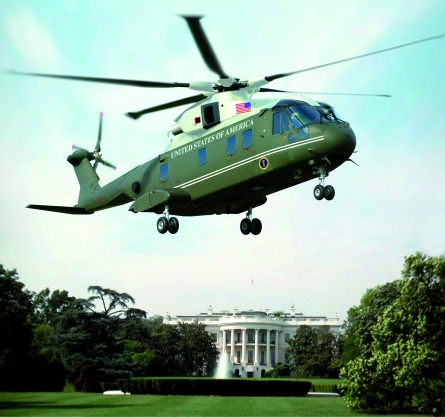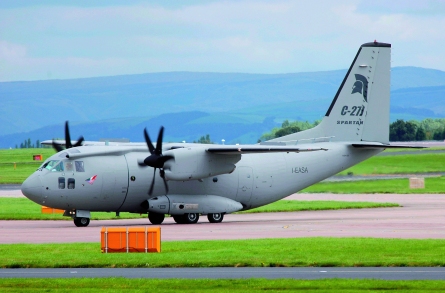Finmeccanica missed out on Europe's defence consolidation, finding solace in the US market. But will it be able to maintain its success?
By accident or design, Italy's Finmeccanica was left out of the consolidation spree that created western Europe's two multinational defence and aerospace consortiums - BAE Systems and EADS.
Finmeccanica adopted an expansion strategy focused partly on the UK, but also on the USA. Over the past decade, Finmeccanica has sought to expand a foothold with civil helicopters and airliners to full-scale manufacturing and a rising share of the lucrative North American defence market.
Finmeccanica along the way has entered a series of joint ventures and collaborations over the past decade that has grown to involve nearly every major civil and military aerospace player in the USA.
"We have deliberately decided to go with primes to enter the market, not because it is necessarily an easier way in, but we think a more effective way in, because of the knowledge that you need to prime contracts of this nature in the Department of Defense environment," says Finmeccanica UK chief executive Alberto de Benedictis.
Finmeccanica employs about 1,800 people spread in the USA, in markets ranging from aerospace, to homeland security to railways.
|
|---|
"Miscommunication" over certification standards for the VH-71 led to a major redesign |
Its aerospace manufacturing footprint in the USA is dominated by an AgustaWestland rotorcraft centre of operations in Philadelphia, the Global Military Airlift System joint venture with L-3 Communications in Greenville, Texas and Huntsville, Alabama and the Global Aeronautica joint venture with Vought in Charleston, South Carolina, which is dedicated to assembling fuselage sections for the Boeing 787.
Manufacturing operations now encompass the A109 Power, the A119 Koala and the AW139 in Philadelphia. Plans are in place to shift production of Alenia Aeronautica's C-27J transport from Turin to a Boeing facility in Jacksonville, Florida by 2011.
But Finmeccanica's determined campaign during the last decade to establish an operational presence in the US market has met success despite many delays and setbacks.
The background behind the C-27J's selection for the US Air Force/Army $2 billion Joint Cargo Aircraft contract last June validates the company's perseverance in the US market, but also demonstrates the challenges of competing against entrenched domestic rivals.
The C-27J was jointly conceived and developed by Alenia Aeronautica and Lockheed Martin in 1995 as an offset requirement for Italy's purchase of the C-130J, which shares the avionics and engines of the C-27J.
The Lockheed/Alenia team originally aimed the C-27J marketing strategy at the US Coast Guard's Deepwater programme. But despite Lockheed's role as a Deepwater prime, the C-27J lost the bid for the coastguard contract in 2002 after Lockheed's selection team picked EADS Casa's more diminutive CN-235.
After the US Army created a requirement for what became JCA in 2003, Alenia passed over Lockheed to form a new partnership with L-3 Communications. Lockheed attempted to offer the C-130J as a competitor for the JCA contract, but was disqualified by the US Army. Alenia and L-3 finally prevailed over the EADS Casa C-295 to win the contract.
Even AgustaWestland's landmark victory in the presidential helicopter competition with Lockheed and the US101 has been tainted by subsequent setbacks.
First, Lockheed blamed a "miscommunication" with the US Navy over certification standards for the US101-based VH-71 presidential helicopter, requiring AgustaWestland to redesign major portions of the aircraft.
The Lockheed and AgustaWestland team has failed so far to consolidate the US101's victory in the follow-up competition to build 141 combat search and rescue helicopters for the US Air Force. Voicing concern about the Lockheed-AgustaWestland team's ability to meet the USAF's delivery schedule, USAF officials instead selected the Boeing HH-47 Chinook, which did not require an engine upgrade to meet the objective requirement.
However, the CSAR-X contract remains open for bidding because the USAF's original decision was overturned by the US Government Accountability Office.
Beyond CSAR-X, AgustaWestland hopes to compete for a follow-on USAF order for a common vertical lift support platform worth an estimated $2 billion.
Canada's Department of National Defence, meanwhile, has a long-standing requirement to replace its fixed-wing search and rescue fleet. The C-27J is considered the prime candidate, with the C-295 also in the running.
In the long term, the USAF and USN are expected by the middle of the next decade to need to replace their Northrop T-38 and Boeing/BAE T-45 trainer fleets. Alenia is seeking partners in US industry to offer the Alenia Aermacchi M-346, but will likely face competition from a new version of the T-45 Goshawk and the Korea Aerospace Industries/Lockheed T-50 Golden Eagle.
The trainer may give Finmeccanica its first opportunity to offer a bid independently of a traditional, US-based prime. "Will we be able to do things on our own in future? Possibly, but so far it's been successful with the [US]101 and the C-27J with the L-3-led team."
Finmeccanica, along with other European firms, has found two routes during the last few years to successfully penetrate a US defence market that has effectively doubled in size during the past decade.
|
|---|
Selection of the C-27J for the US Air Force/Army will result in a Florida-based production line |
The starting point to have any success has been first establishing a firm operating base on US soil, and this has been achieved either through acquisition or through transferring all or pieces of a production system from Europe.
The latter route is available almost exclusively to UK industry - namely, BAE and Rolls-Royce. BAE has exploited its privileged relationship with the US gatekeepers of sensitive industrial capabilities to acquire Lockheed Martin-Sanders in 1998 and United Defense in 2005, among more than a dozen smaller deals.
The second route - transitioning manufacturing and operations from Europe to the USA - is slower and more risky, but has generated successful results for the rest of European industry, principally EADS and Finmeccanica.
After 2001, Finmeccanica set out from Europe to capture market share in the world's largest market for defence and aerospace products that was at that time in the midst of a historical growth spurt.
According to the Government Electronics and Information Technology Association (GEIA), US spending on military aircraft rose from about $27 billion in fiscal year 1997 to about $55 billion in FY2008.
The growing market created room for the entrance of European competition, particularly in niche markets vacated by US companies.
In addition, with the US industry in consolidation mode since 1993, the US Department of Defense began courting European competitors to avoid awarding sole-source contracts to US vendors with a domestic monopoly.
For both EADS and Finmeccanica, this created new opportunities in the light and heavylift helicopter markets, as well as significant interest in the medium airlift sector.
For all of Europe's gains made since 2001, questions are beginning to arise about how much longer the growth can be sustained and whether contract awards received so far can lead to wider opportunities. Having cracked open the door, European competitors could still see many of the gains of the past few years wiped out.
The US defence aerospace market is set to begin a prolonged contraction after a decade of furious growth. The GEIA's forecast unveiled in October predicted US spending on military aircraft will decline from $55 billion to $47 billion in 10 years, as measured in current-year dollars. The lack of growth will dramatically increase the pressure on US defence contractors to maintain expansion, perhaps squeezing out foreign competition through a combination of political pressure and lost opportunities.
Source: Flight International


















